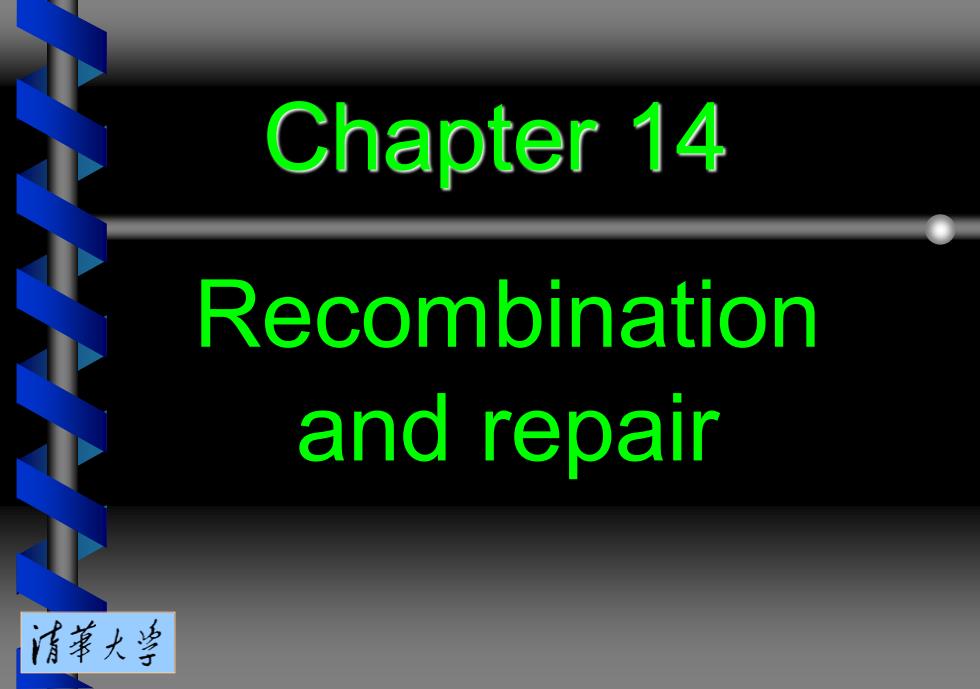
Chapter 14 Recombination and repair 清苇大当
Chapter 14 Recombination and repair
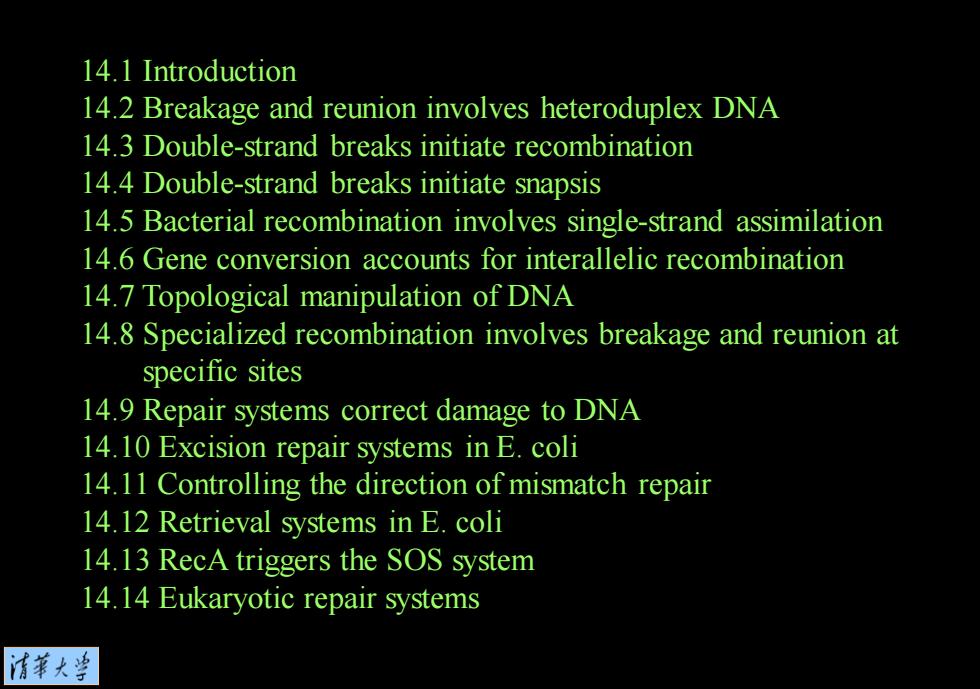
14.1 Introduction 14.2 Breakage and reunion involves heteroduplex DNA 14.3 Double-strand breaks initiate recombination 14.4 Double-strand breaks initiate snapsis 14.5 Bacterial recombination involves single-strand assimilation 14.6 Gene conversion accounts for interallelic recombination 14.7 Topological manipulation of DNA 14.8 Specialized recombination involves breakage and reunion at specific sites 14.9 Repair systems correct damage to DNA 14.10 Excision repair systems in E.coli 14.11 Controlling the direction of mismatch repair 14.12 Retrieval systems in E.coli 14.13 RecA triggers the SOS system 14.14 Eukaryotic repair systems 清菜大当
14.1 Introduction 14.2 Breakage and reunion involves heteroduplex DNA 14.3 Double-strand breaks initiate recombination 14.4 Double-strand breaks initiate snapsis 14.5 Bacterial recombination involves single-strand assimilation 14.6 Gene conversion accounts for interallelic recombination 14.7 Topological manipulation of DNA 14.8 Specialized recombination involves breakage and reunion at specific sites 14.9 Repair systems correct damage to DNA 14.10 Excision repair systems in E. coli 14.11 Controlling the direction of mismatch repair 14.12 Retrieval systems in E. coli 14.13 RecA triggers the SOS system 14.14 Eukaryotic repair systems
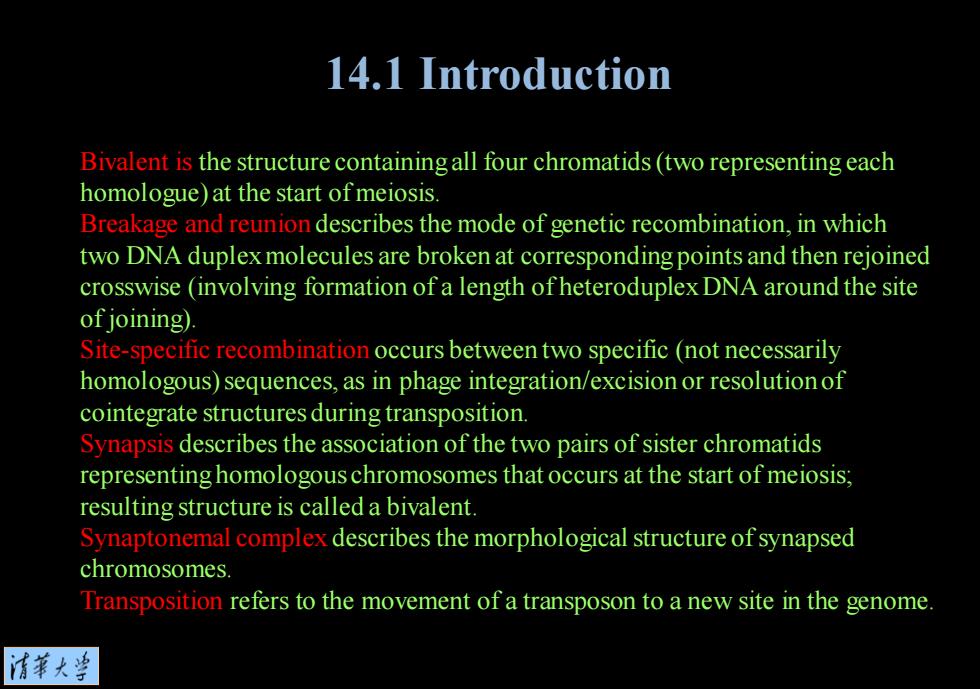
14.1 Introduction Bivalent is the structure containing all four chromatids(two representing each homologue)at the start of meiosis. Breakage and reunion describes the mode of genetic recombination,in which two DNA duplex molecules are broken at corresponding points and then rejoined crosswise (involving formation of a length ofheteroduplex DNA around the site of joining). Site-specific recombination occurs between two specific(not necessarily homologous)sequences,as in phage integration/excision or resolution of cointegrate structures during transposition. Synapsis describes the association of the two pairs of sister chromatids representing homologous chromosomes that occurs at the start of meiosis; resulting structure is called a bivalent. Synaptonemal complex describes the morphological structure of synapsed chromosomes. Transposition refers to the movement of a transposon to a new site in the genome 清菜大当
Bivalent is the structure containing all four chromatids (two representing each homologue) at the start of meiosis. Breakage and reunion describes the mode of genetic recombination, in which two DNA duplex molecules are broken at corresponding points and then rejoined crosswise (involving formation of a length of heteroduplex DNA around the site of joining). Site-specific recombination occurs between two specific (not necessarily homologous) sequences, as in phage integration/excision or resolution of cointegrate structures during transposition. Synapsis describes the association of the two pairs of sister chromatids representing homologous chromosomes that occurs at the start of meiosis; resulting structure is called a bivalent. Synaptonemal complex describes the morphological structure of synapsed chromosomes. Transposition refers to the movement of a transposon to a new site in the genome. 14.1 Introduction
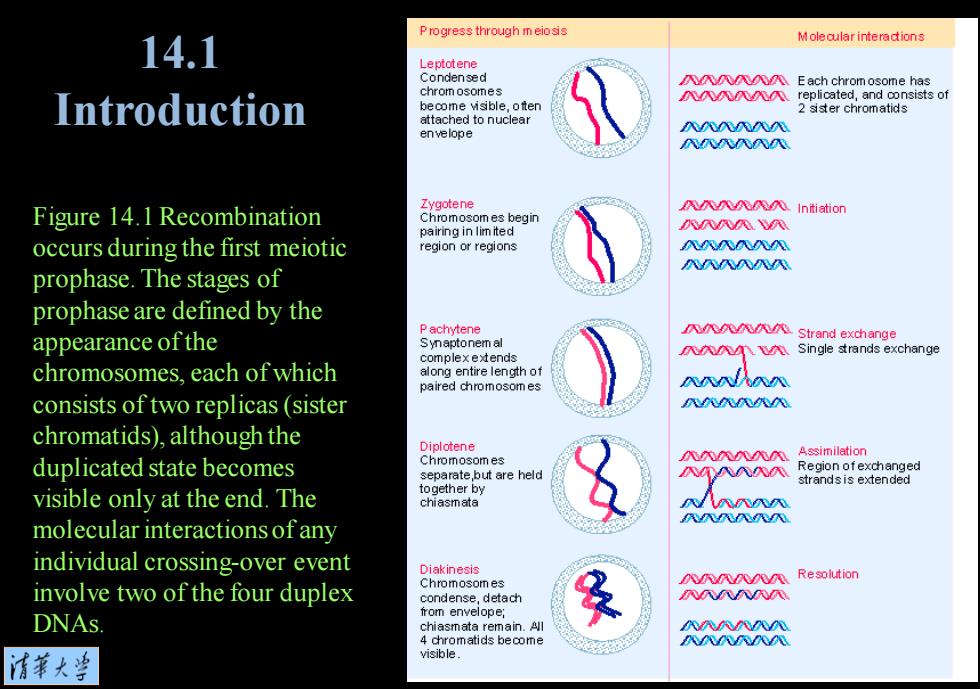
Progress through meiosis 14.1 Moleoular interadions Leptotene Condensed 入入Each chromosome has chrom osomes Introduction N八、replicated,and consists of become visible,often 2 sister chromatids attached to nuclear envelope 八八入M八八 八八八八 Figure 14.1 Recombination Zygotene 入入入入入Initiation Chromosomes begin pairing in lim ited 八八N occurs during the first meiotic region or regions N八NMN 八风八八八N prophase.The stages of prophase are defined by the Pachytene appearance ofthe Synaptonem al 八X八八Strand exchange Single strands exchange complex extends 入代A六 chromosomes,each of which along entire length of paired chromosomes 八人入N consists of two replicas(sister 风风风风代 chromatids),although the Diplotene 六六N代的 Assimilation duplicated state becomes Chromosomes separate,but are held 闭八八 Region of exchanged visible only at the end.The together by chiasmata 风八风代 molecular interactions of any individual crossing-over event Diakinesis Chromosomes 八N Resolution involve two of the four duplex condense,detach DNAs. from envelope; chiasmata remain.All 八八八八代N 4 chromatids become 八NA凡 清菜大当 visible
Figure 14.1 Recombination occurs during the first meiotic prophase. The stages of prophase are defined by the appearance of the chromosomes, each of which consists of two replicas (sister chromatids), although the duplicated state becomes visible only at the end. The molecular interactions of any individual crossing-over event involve two of the four duplex DNAs. 14.1 Introduction
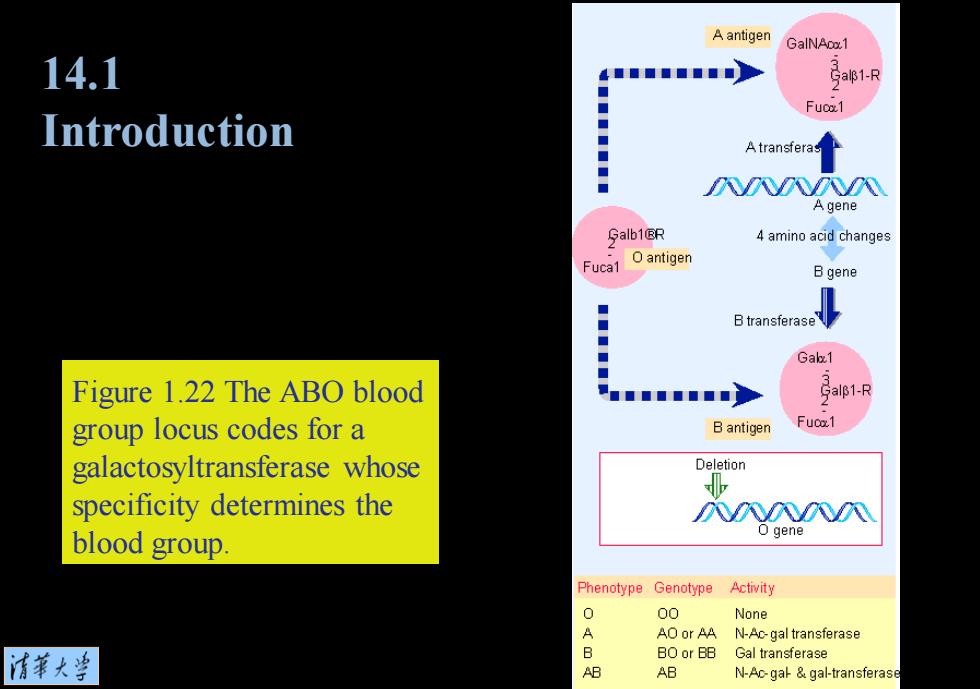
A antigen GalNAD 14.1 61R Fuco1 Introduction VMV A gene 9alb1®r 4 amino acid changes Fuca1 Oantigen Bgene ◆ B transferase Gak1 Figure 1.22 The ABO blood ◆ o group locus codes for a Bantigen Fuoo1 galactosyltransferase whose Deletion specificity determines the DVV blood group O gene Phenotype Genotype Activity 00 None A AO or AA N-Ac-gal transferase 清菜大当 BO or BB Gal transferase AB AB N-Ac-ga gal-transferas
Figure 1.22 The ABO blood group locus codes for a galactosyltransferase whose specificity determines the blood group. 14.1 Introduction